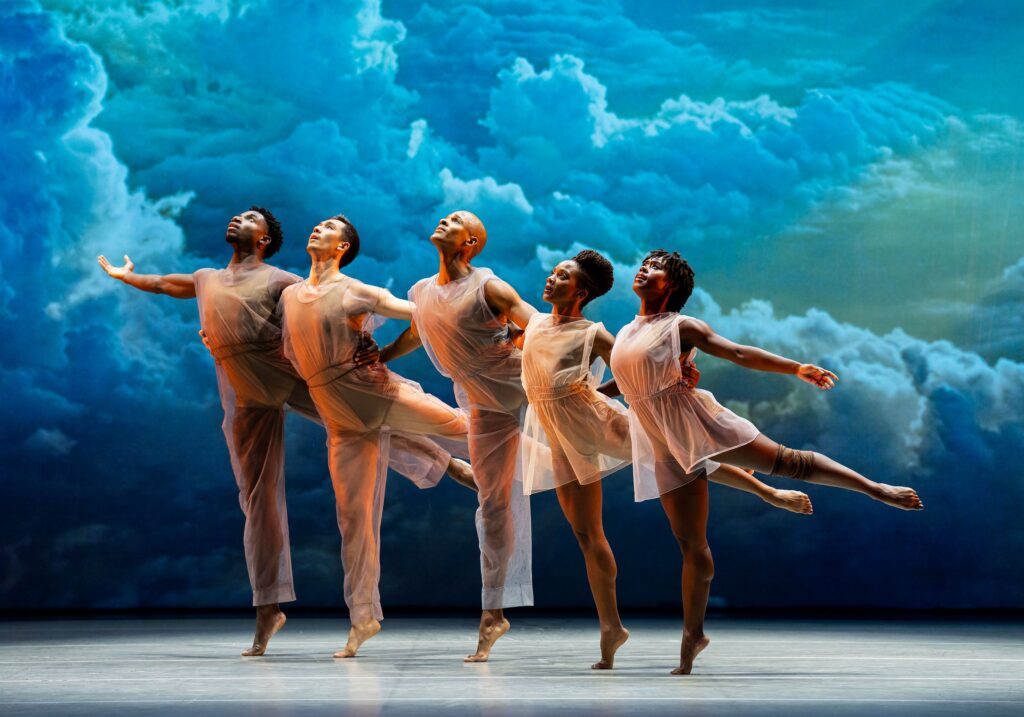
Alvin Ailey American Dance Theater. Presented by Celebrity Series of Boston. At Boch Center Wang Theatre. Run has ended.
By Shelley A. Sackett
Like daylight savings time, red-winged blackbirds and early flowering trees, Celebrity Series of Boston’s presentation of Alvin Ailey American Dance Theater is an annual harbinger of spring. Its arrival is cause for celebration for the reliably breathtaking performances that await and as a sign that, at last, the long, dark, COLD winter months are behind us.
The Saturday, April 26 matinée was a special treat; its program included both Sacred Songs and Many Angels in addition to Revelations, Ailey’s most celebrated work and a cornerstone and frequent feature of the company’s repertory.
When Revelations was first performed in 1960, it was twice as long as the version now performed. A dancer and choreographer, Ailey company member Matthew Rushing became its Rehearsal Director in 2010, Associate Artistic Director in 2020, and Interim Artistic Director in 2023. In 2024, Rushing and Ailey Music Director, Du’Bois A’Keen (himself a dancer and composer), gathered the songs that were removed from the original Revelations and reimagined them as a more contemporary version of the piece. The wanted their version to still showcase African American cultural and historical heritage, but to also resonate with a 21st century audience. Sacred Songs was the result.
The piece begins with house lights up and 10 dancers seated on stools, reminders of Revelations and the women seated on stools in “Rocka My Soul.” Rushing’s Sacred Songs pays homage to Revelations, but bears his fingerprints. Its playlist is edgier, and includes funk, updated arrangements of spirituals, calypso, big, brassy jazz and Hendrix-like fuzz guitar. Its choreography is more lighthearted and less muscular. There are even moments of thoughtful introspection set to a soundtrack that is literally no more than a whisper.

Ailey based Revelations on his childhood memories, where church played an important role. Traditional Black spirituals, work songs, and blues both reflected Black American history, with its roots in slavery, and honored Black perseverance and faith.
Rushing’s choreography is overall more celebratory and looser than Ailey’s, his dancers more earthbound. They express pain and joy as they soar and collapse, exalt and pray. They leap, melt and sway with the flexibility of boneless cartilage. When they reach for the sky, palms turned up, the stage lights with hope. Next moment, they are in a speakeasy with the frenzy and excitement of living on the edge in the moment.
Again and again, we marvel at the troupe’s gravity-defying moves and acrobatic-like prowess, wondering almost aloud, “How DO they do that?” Miranda Quinn and James Gilmer are particular standouts in an ensemble of universal excellence, their time on stage glimpses of earthly blessing.
Andre A. Vazquez’s stunning lighting with its nuanced use of spotlights and color, and Danté Baylor’s simple but elegant billowing costumes complete without competing. When the final section winds down with the ensemble kneeling beneath a blue-tinged lighting, as if by a pool of water, the effect is of a stiller, more contemplative version of Revelation’s “Wade in the Water.” Rushing has done an amazing job of remaining loyal to Ailey’s original while creating a signature piece of his own.

After an intermission, the program’s palate cleanser and highlight (for this reviewer) silently bursts into view as the curtain rises on world-renowned Lar Lubovitch’s first work for the Alvin Ailey company, Many Angels. A backdrop of Michelangelo-like clouds celestially lighted (designed by Lubovitch) beams the audience inside the Sistine chapel’s heavenly ceiling, among angels. In setting his piece to Gustav Mahler’s lofty “Adagietto” from Symphony No, 5 in C-Sharp Minor, Lubovitch was inspired by 13th century theologian St. Thomas Aquinas, who famously asked, “How many angels can dance on the head of a pin?”
A mound of five dancers adorn the stage, arranged jenga-like in a soft mass. Slowly, they disentangle, arms gracefully reaching upwards as the pile separates into unique bodies. Clad in sheer, shimmering other-worldly costumes of luscious fabric that catches the light and seems to absorb it (costumes by Harriet Jung and Reid Bartelme), they twist, turn and slide over each other with all the loveliness of, well, angels. With its flowing movements and transcendent moments, the choreography evokes feelings of weightlessness and miracles.
This short piece is entirely ballet, with lifts and poses that take one’s breath away with their grace and sheer beauty. The artistry is stunning, message-less and simple synchronicity of movement and music. As Lubovitch comments in the program notes, “Occasionally, something may exist in the world just for the sake of itself.” He has certainly created such a wonder with his Many Angels.
After a brief pause, the familiar first notes of “I Been Buked” electrifies the seasoned audience with excitement as they ready for the icing on the Ailey cake — the incomparable Revelations, which, no matter how many times witnessed, is always fresh and enthusiastically welcomed. The 30+ minute work has three parts, starting with “Pilgrim of Sorrow.” The words in these songs create a heartbreaking operatic narrative arc of the struggle, pain and burdens of being Black in America. “Fix Me Jesus” is particularly poignant; dancers Corrin Rachelle Mitchell and Yannick Lebrun bring sensitivity and strength to their delicious duet.
Part two takes us to the water and its power to honor, redeem and anoint. Ella Jenkins’ “Wade in the Water” is etched in hope. The dancers are dressed in white with white umbrellas, hankies and streamer flags, creating a joyful mashup of baptism and New Orleans second line (costumes by Ves Harper).

“Move, Members, Move” pays homage to southern matriarchal community life, where women and church were the glue that held it all together. Barbara Forbes dresses the women in sunflower yellow hats, flouncy dresses and fans, and the men in matching vests, billowy shirts and fitted trousers. By the time “Rocka My Soul in the Bosom of Abraham” begins, the crowd is on their feet, clapping and singing and dancing in place. The fourth wall has melted and we are all one community, basking in the pageantry of the magnificent Boch Center Wang Theatre and the pure magic Alvin Ailey American Dance Theater always leaves in its wake.

